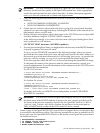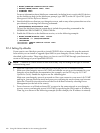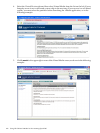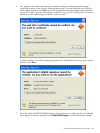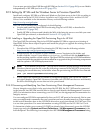
IMPORTANT: For each subsequent upgrade of OpenVMS, you must create a separate
directory for the boot files specific to the OpenVMS version and, where appropriate,
modify the path specified for each client’s boot files. To make subsequent upgrades
easier, you can use systemwide or clusterwide logical names.
c. Copy the following two files from the DVD to the TCPIP$TFTP_ROOT:[V831H1]
directory:
• [SYS0.SYSCOMMON.SYSEXE]VMS_LOADER.EFI
• [SYS0.SYSCOMMON.SYSEXE]IPB.EXE
d. Gather data for each boot client (each node that is going to be provisioned, hereafter
referred to as a provisioning/boot client), including the IP address of the network device
(the Integrity server core I/O card).
e. Define each provisioning/boot client’s host name in the TCP/IP Services for OpenVMS
local host database using the TCPIP SET HOST command.
In the following example, hostname is the host name of the provisioning/boot client
and ipaddress is its IP address:
$ TCPIP SET HOST hostname /ADDRESS=ipaddress
f. For each provisioning/boot client, you might need to add an entry in the BOOTP database
to specify a gateway and network mask.
To do so, use the SET BOOTP command in the following format, where hostname
specified the host name of the boot client, MACAddress specifies the MAC address of
the network port of the boot client used for LAN booting, gateways-ip specifies the
gateways used for routing, ip-network-mask specifies the subnet mask, and
diskname specifies either the DVD or LD device containing the OpenVMS OS image
To determine the names of the gateways and the subnet information, consult your
network administrator. For more information on this command, see the TCP/IP Services
for OpenVMS documentation.
For V8.3-1H1 or lower:
$ TCPIP SET BOOTP hostname /HARDWARE=ADDRESS=MACAddress –
/GATEWAYS=gateways-ip –
/NETWORK_MASK=ip-network-mask –
/FILE=TCPIP$TFTP_ROOT:[V831H1]VMS_LOADER.EFI
For Version 8.4 or later:
$ TCPIP SET BOOTP hostname /HARDWARE=ADDRESS=MACAddress –
/GATEWAYS=gateways-ip –
/NETWORK_MASK=ip-network-mask –
/FILE = <disk_name>[SYS0.SYSCOMMON.SYSEXE]VMS_LOADER.EFI
To display and verify your BOOTP server configuration, use the TCPIP SHOW
BOOTP/FULL command.
IMPORTANT: For each new version of OpenVMS Integrity server, you must modify
the client entry in the BOOTP database to point to the new, version-specific boot file.
As shown in the previous examples, the boot file for OpenVMS Version 8.3–1H1 is
[V831H1]VMS_LOADER.EFI and for Version 8.4 and later it is the actual path to
VMS_LOADER which is either in the DVD or the LD device created.
3. Create a copy of the OpenVMS OE DVD on an LD device (logical disk or virtual drive) that
is accessible to the InfoServer utility. The following example shows how to establish an LD
device and copy the OpenVMS DVD (DNA0:) to the device on an OpenVMS system that is
the InfoServer server:
$ @SYS$STARTUP:LD$STARTUP
$ LD CREATE I64084.DSK/SIZE=6005000
$ LD CONNECT I64084.DSK
$ MOUNT/FOREIGN/NOASSIST LDA1:
D.1 HP SIM Provisioning of OpenVMS 249











